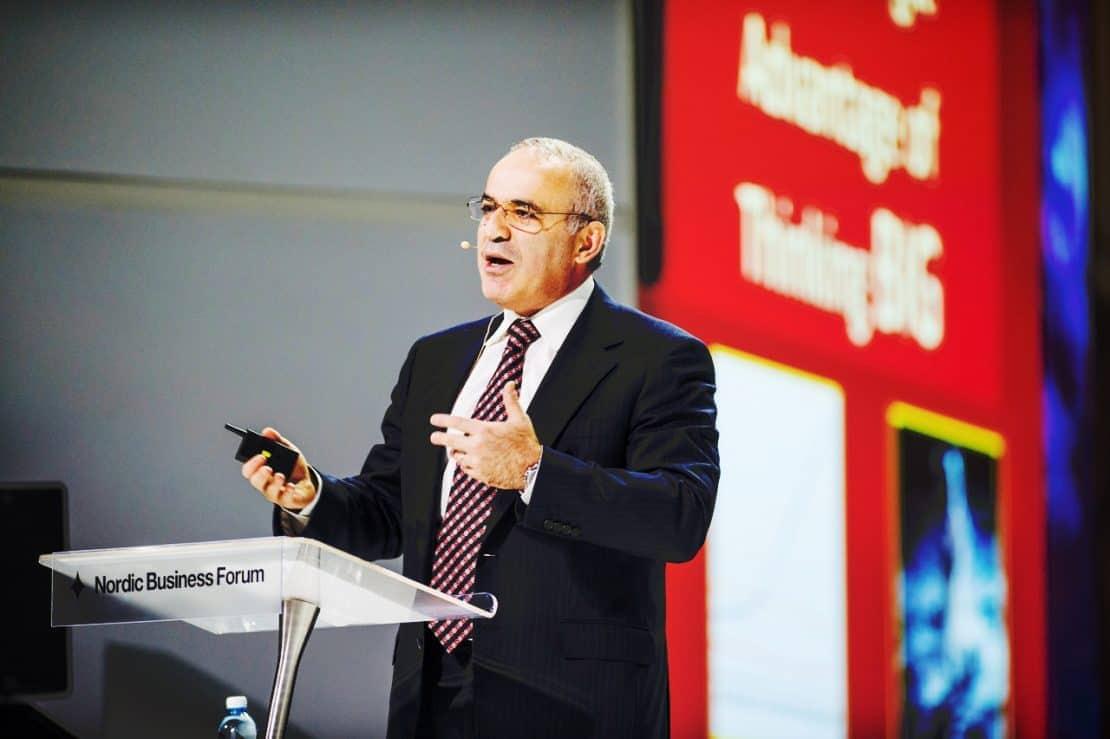16Dec2015
Cunningham’s presentation offered clarity about the main responsibilities of a CEO.
As Keith J. Cunningham was welcomed to the stage, you couldn’t help but notice the deference with which he took the greeting. Humbly he quipped, “you might wanna hold your applause, I might not be that good.” As his speech progressed, the advice he gave and the ideas he shared were worth the acknowledgment he received – and then some!
A Texan
Although stating how nervous he was, it’s safe to say he didn’t show it, and his gravelly Texas accent was playful and confident. Like many good speakers he began with a joke to warm us up (and perhaps settle his nerves). It was a situation in which an audience participant of a talk he once gave in his home state of Texas, fell asleep during his presentation. His performance of the man snoring and his own anxiety at potentially being so dull had the Nordic Business Forum audience in raptures. The punch line was even better, as he described the way the man came up to him at the end of his talk to say, “you and I are in the same business!” Shocked, Cunningham responded, “you gotta be kidding me, what do you do?” To which the man’s reply was, “I’m an anaesthesiologist too!”
The game of business
From jokes we swiftly moved onto games, especially ‘the game of business.’ Cunningham made no attempt to hide his amazement at the way people run their businesses. For Cunningham, business is an intellectual sport, however he finds that far too many are playing the game blindfolded. “That’s how most of us try to run our businesses, were playing ‘whack a mole’ with our businesses.” They are not taking advantage of the intellectual resources they have at their disposal. For Cunningham, “the people who win the game of business are the people who have the …business skills and tools.” Another analogy he gives is that of visiting the doctor. When you do they investigate and run analysis. “Why do doctors [do this]? It’s because they can’t tell how you’re doing by looking only at the surface.” Cunningham expresses his frustration at seeing so many hard-working people go out of business because they aren’t playing the game intellectually, because they haven’t diagnosed what their real problems are!
The four responsibilities of a CEO
For Cunningham there are four areas of responsibility that a CEO or business owner “cannot delegate”.
These are:
- The organisational chart
- The organisational culture
- The strategy/machine
- The allocation of resources
The organisational chart is all about recruitment and getting the right people to produce the right outcomes. “I’m all in favour of getting the right people on the bus, but… it’s much more important to make sure that whoever’s on that bus is producing the right outcomes.” Before this comes culture and according to Cunningham, “in our day and age, we’ve gotten the word ‘perk’ and ‘culture’ confused.” As Cunningham asserts, bringing your dog to work or building a gym is not culture, it’s a perk!
The culture for Cunningham’s employees boils down to these three principles:
“1) Let’s do the right thing, 2) Let’s do the best we can, 3) Let’s show other people that we care.”
These, according to Cunningham, are his “rules of the game.” He believes a good culture would also have accountability. Then there is the strategy or, as Cunningham refers to it, ‘the machine.’ The strategy is just another word for a plan to get over an obstacle that is preventing you from achieving your goal. Every single problem can be an opportunity if you choose to view it this way. Finally, Cunningham explains that the allocation of resources is the last thing a CEO cannot delegate. For Cunningham, misallocation of resources is “what undermines most people’s success.”
The two reasons to spend money
Moving deeper into the allocation of resources, Cunningham is very adamant that there are really only two reasons to spend money. One, is “to keep the customers we got…[and] reason number two is to get new [customers].” This boils down to “getting people to notice what we do…[or] doing something that people will notice.” One of the most important points of Cunningham’s presentation is: “How big would your business be if you still had every customer that ever tried you?” It is a very important question that in his experience is ignored by businesses. Keeping customers rather than worrying about attracting new ones is simple but often over-looked.
Once again return to the question of misdiagnosis. Cunningham asks the audience why their company isn’t bigger? Is it because they “don’t have enough customers, …[or maybe] because customers are not buying enough? Could it be that customers are not returning? Maybe the problem is we don’t have enough prospects?” What Cunningham points out is these are not problems but “symptoms.”
Where’s your ‘is’ line?
In our lives and in our businesses we all have an ‘is’ line.
This is Cunningham’s favourite teaching tool and represents the line that intersects the graph between the horizontal ‘what is’, and the vertical ‘what ought’. Basically Cunningham feels that too many of us are naïve about what the real state of our business is. “I think that most people don’t do a very good job of telling the truth about where they are. I think we tend to sugar-coat it.” Cunningham talks about getting “clarity” through “optics” – the tools and questions that really help you to understand and identify your real problems. Cunningham warns that, “if you’re solving the problem that isn’t, you’ll make no progress.”
Schedule time to think!
One of Cunningham’s favourite stories is when he had a meeting with a prominent businessman by the name of Mike Milken. In the “biggest deal of [his] life” he needed to impress Mr Milken with his presentation in order to secure funding for a takeover. During this meeting he overhears Mr Milken inform his assistant that the “decision on the takeover of Gulf Oil” will be provided immediately following the next point at which he is “scheduled to think.” Aside from being impressed about the takeover of Gulf Oil, Cunningham is even more amazed that someone as busy as Mr Milken actually schedules time to think. He considers this to be a great piece of advice, but explains that the key to effective thinking is to ask “yourself a really good question!”
Cunningham provides us with a number of examples of really good questions to illustrate his point:
- How did this get to be a problem to begin with?
- What could I do to improve my situation?
- If I could _________ really, really well, I could solve this problem
- Where have we tolerated mediocrity, lowered our standards or allowed inconsistent execution to become an acceptable performance criteria?
For Cunningham this last question really got him excited: “Boy… talk about a world-class question.”
Questions to find your strategy
Taking this approach further, Cunningham showed us how this can help build our business strategy. He cites the case of Southwest Airlines, a company in the US that has made more money in the last year than the rest of the aviation industry has done since the Wright Brothers! “Their statement of the problem is – a plane on the ground makes no money. Well that’s obvious! You know what their strategy is to keep their planes in the air – get really, really good at baggage handling.”
Once again Cunningham has a helpful set of points to guide our strategic thinking:
- Who do I want to buy from me?
- What must happen to cause them to buy?
- What must happen to keep them buying?
- What could cause them NOT to buy?
Why are they not buying from me?
Cunningham expands on the purchasing decisions by giving us some helpful tips. He cites four reasons why customers might be turned away. Firstly, Cunningham points out that “customers say no because there’s a risk! There’s a risk of making the switch.” Then Cunningham warns us against the dangers of creating “friction,” such as offering something for free but then asking for personal information in exchange. The third reason is that “some people say no because they don’t understand the difference that makes the difference.” You need to know why you are better and communicate that effectively. Finally, “people say no because they lack certainty of success.”
Tell me how it is, coach!
Cunningham summarizes his talk with the following points:
- Allocation of resources: Keep Existing.
- What is the REAL problem?
- THINK: Genius = Questions.
- Let’s simplify this.
When you examine these final points it seems that they are very simple. However, each point provides a fantastic guide for how to logically assess the state of your business and to then build an appropriate ‘machine’ or strategy to deal with the challenges. Cunningham quotes Albert Einstein, who said, “the questions never change, just the answers.” The assessment that Cunningham draws from this is that things never stay the same. “A great idea five years ago might be a lousy idea today. A lousy idea today could be a great idea 6 months from now.”
Cunningham finishes his presentation with a quote from a man named Paul ‘Bear’ Bryant. The renowned American Football coach, with a phenomenal success rate, was often seen reading a small piece of paper he kept in his wallet. After his death some years ago, that paper was discovered. Bellow you can read what was written on the paper. My recommendation is that you cover and read each line individually. Every word is worth fully appreciating!
This is the beginning of a new day.
God has given me this day to use as I will.
I can waste it or I can use it for good.
What I do today is very important because I am exchanging a day of my life for it.
When tomorrow comes, this day will be gone forever,
Leaving something in its place that I have traded for it.
I want it to be gain, not loss – good, not evil, success, not failure,
In order that I shall not forget the price I paid for it.
American entrepreneur, international speaker and acclaimed author, Keith J. Cunningham is regarded as one of the foremost authorities on business mastery. With more than 40 years of business and investing experience, Keith has taught critical business skills to thousands of top executives and entrepreneurs around the world. For more information on Keith and his business school, please visit www.keystothevault.com.



